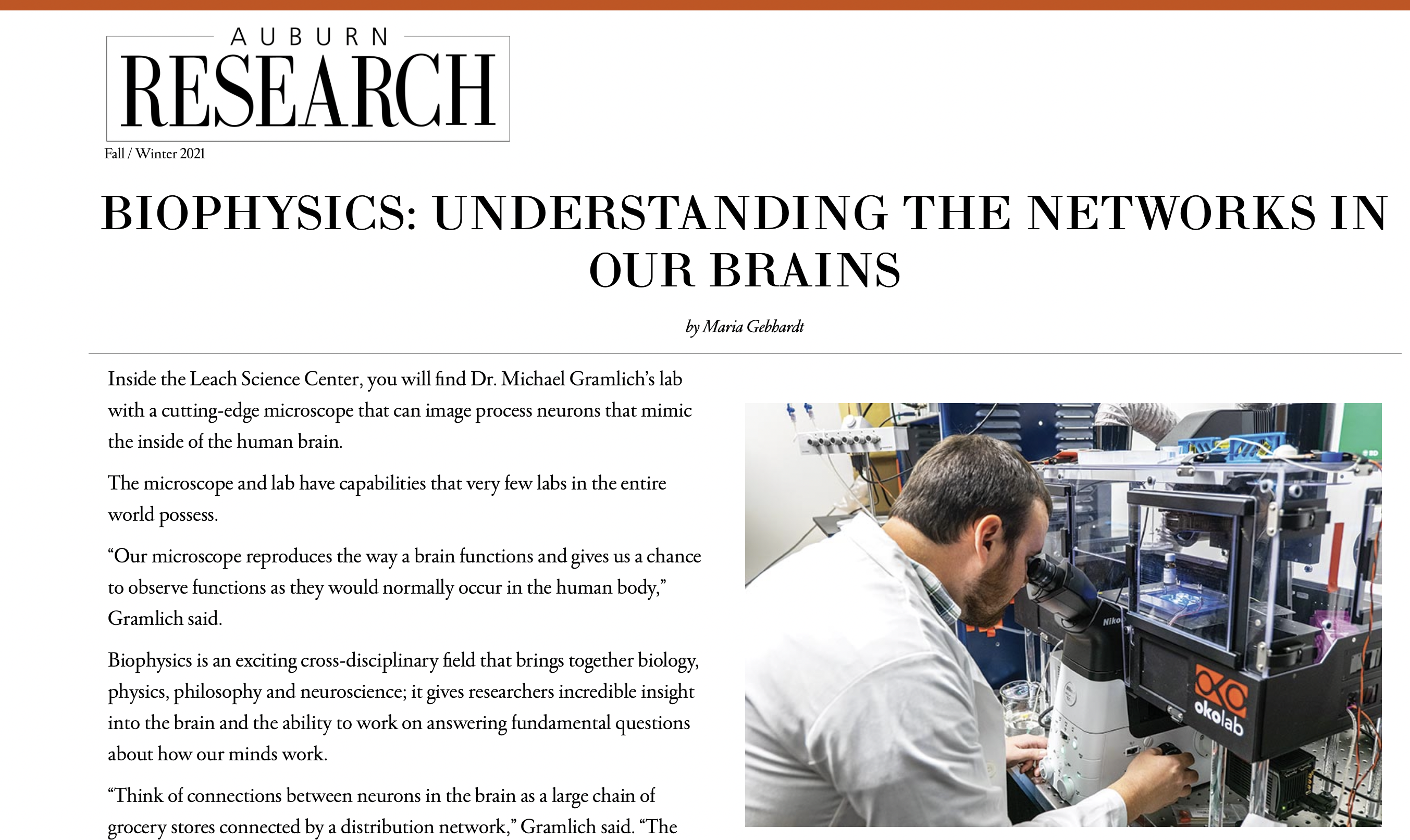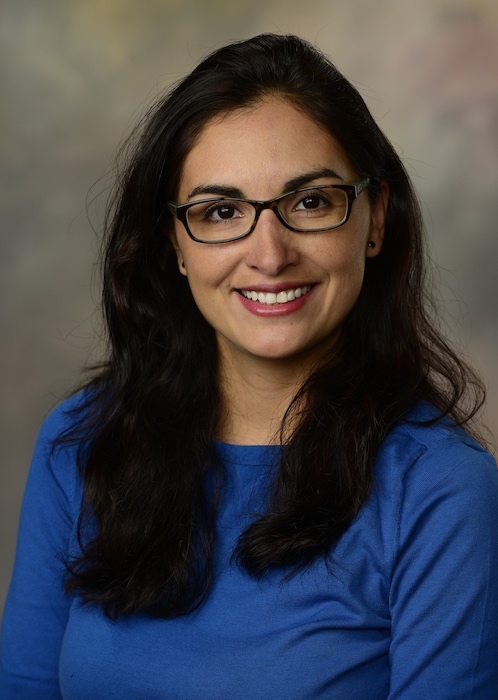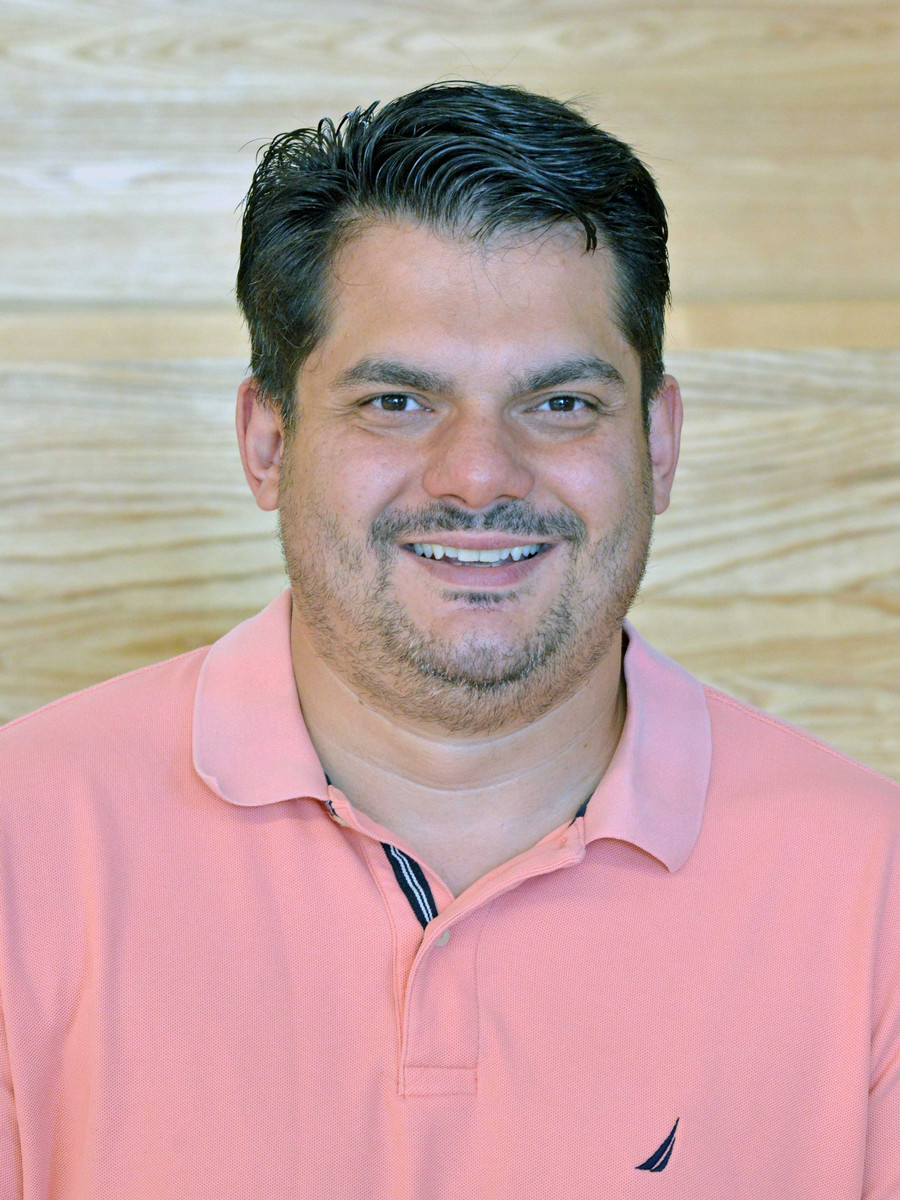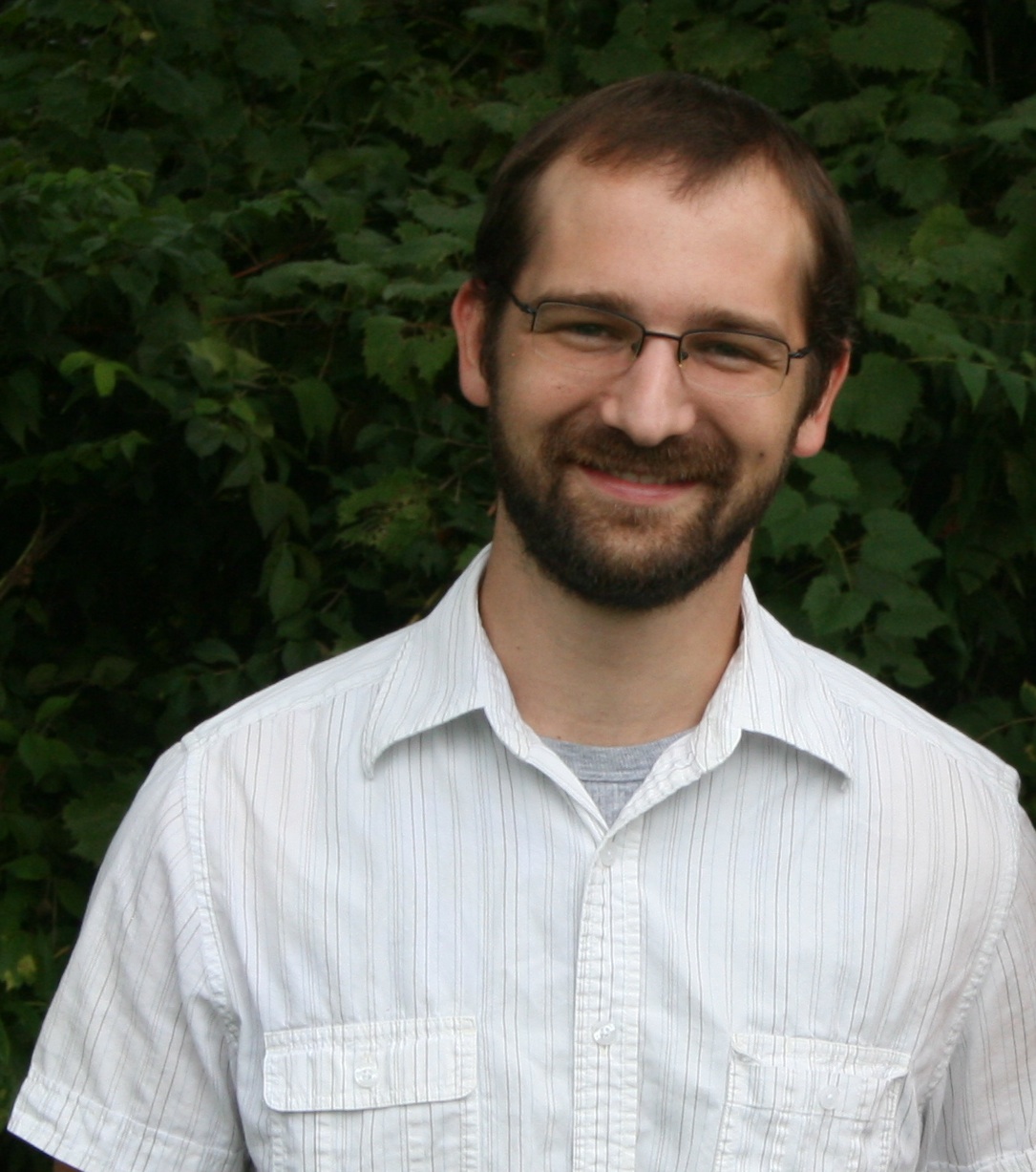Biophysics
Biophysics at Auburn University

Read the article online that is featured in the fall 2021 issue of Auburn Research.
Biophysics Cluster Overview
The goal of biophysics cluster is to foster cutting-edge biological research at Auburn University. The use of the physical tools and approaches revolutionized all venues of biological sciences and modern medicine. The biophysical research is interdisciplinary and is done across COSAM involving Biology, Chemistry and Physics departments. Auburn University and the cluster provide critical combination of resources, student training, and research opportunities in biophysics.
Current Researchers Student Training Research Resources
Faculty

Adriana Avila-Flores (Biology)
Avila-Flores focuses on the design of nanoparticles that can improve the performance of drugs, by facilitating their translocation across cell membranes. These nanoparticles are made of biocompatible materials and can be designed to target specific cell types.
Learn More

Rafael C. Bernardi (Physics)
Bernardi's research focuses on computational biophysics, particularly on mechanobiology and the development of computational biophysics/chemistry tools. His research team is part of the NIH Center for Macromolecular Modeling and Bioinformatics, which is known worldwide for the development of both NAMD and VMD software.
Learn More

Michael W. Gramlich (Physics)
Gramlich provides the expertise of molecular biophysics, neuroscience, and high-resolution fluorescence microscopy. He works on single particle studies in live neurons and provides a traditional physics background perspective to joint projects in the group. Gramlich offers insight regarding the spatial/temporal connection between molecular mechanics and cellular function within the research cluster.
Learn More

Alexey Petrov (Biology)
Petrov's group studies mechanisms of protein synthesis and regulation of translation using single-molecule methods. Single molecule fluorescence and FRET allow real-time tracking of ribosomes, translation factors and RNAs and their conformational dynamics on millisecond to seconds time scale. The aim is to delineate mechanisms and regulation of translation and leverage it understand the origination and progression of translation linked diseases.
Learn More

Joanna Sztuba-Solinska (Biology)
Sztuba-Solinska provides the expertise in the field of viral non-coding RNA structure, RNA structure-mediated interactions with effector molecules, i.e. other RNAs, proteins, DNA, and RNA as a small molecule drug target. She has a background in molecular virology, biochemical RNA probing techniques, including SHAPE, SHAPE-MaP, aiSHAPE, traditional chemical probing, and bioinformatic deconvolution of the deep-sequencing data. The main goal of her research is to find the “weak spot” in viral non-coding RNA interactome network that can be tackled with novel small molecule therapeutics.
Learn More
Training timeline for graduate students
Graduate students are accepted into departmental programs (Physics, Biology, Chemistry, and Mathematics) and will graduate with a PhD in their respective department. Thus, students follow their respective department requirements and timelines. Students will be taking biophysics specific classes alongside or in lieu of the program specific courses.
Undergraduate training
The majority of biophysics classes are open for undergraduate students.
Courses
Introductory Biophysics
(BIOL5970/7970 2 credit hours, Spring)
Introductory biophysics is the entry level course introducing the general concepts of biophysics. The course discusses what the biophysics is, with the aim of linking biophysical principles to the organismal functions. Thus, it discusses the wide variety of subject ranging from dinosaurs to cell biology. The course is specifically tailored for the students who are considering the future carrier in the medical or biological fields as well as to biology curious students from other disciplines. The students will learn about physiology of heart and lungs, how sight, hearing and olfactory senses work. The separate section is devoted to discussing recent technological advances, such as subdiffractional imaging, nano-manipulations, novel spectroscopic and structural methods and how they reshape our knowledge of biology.
Often this class is taken several years after calculus and physics classes. This is taken into account by using the simple mathematical and physical concepts to dissect the biological and refraining from heavy formula derivation and proofs.
RNA in Biomedicine (by Dr. Solinska)
RNA is a key molecular player involved in regulation of biological processes at all levels. Dysregulation of these processes often leads to various human disorders, including cancer. This course introduces the basic and novel types and functions of RNAs, as well as the integration of these molecules in biomedical contexts. Students will learn about the ‘RNA World’ theory, the diverse roles of RNA in cellular processes and pathogenesis. Technological approaches to RNA research will be covered, as well as the application of this research to the diagnosis and therapy of genetic diseases.
After completing this class, students will:
- Understand the chemical structure of RNA and the structure motifs in RNA.
- Have a good understanding of the experimental and computational methods in RNA biology research.
- Understand the catalytic and structural properties of ribozymes, riboswitches and RNA thermometers, as well as their application in biomedicine
- Understand the role of various non-coding RNAs, i.e. micro RNAs, long non-coding RNAs, circular RNAS in biological processes and human diseases
- Understand the mechanism of RNA interference in both eukaryotes and prokaryotes.
- Understand the role of RNA in RNA-based therapies against genetic diseases i.e. spinal muscle atrophy (SMA), Duchenne muscular dystrophy (DMD)
- Gain practical skills in predicting RNA secondary and 3-D structure, using online tools for predicting RNA involvement in cellular processes and pathogenesis, building RNA-based nanoparticles for drug delivery
BIOL 4970/7970 Nanomedicine
Nanomedicine is an emerging field that deals with materials at the nanometer scale that have medical applications. This new medicine area offers new strategies for the treatment and diagnosis of diseases. This course will teach the origin, composition, biophysical characterization and medical application of nanoparticles, nanodevices, nanosensors and nanorobots recently developed.
Upcoming Courses
Biophysics Journal Club
Survey of Biophysics: From molecules to organisms
Experimental Biophysics Techniques
This course surveys common experimental methods used in biophysics research. The course outlines strengths and weaknesses for each technique. Students will read canonical publications for each technique as well as select publications outlining the techniques development.
Computational and Theoretical Biophysics Techniques
This course surveys common methods used in computational and theoretical biophysics. Students will survey basic programming skills. Students will learn how to use computational tools to support and lead experimental data. Lastly, students will develop a single problem to solve with computational methods.
Seminar on “Soft Skills for Scientists”:
We provide resources that utilize molecular biology techniques related to RNA, DNA and protein analyses, single molecule fluorescence microscopy, nanotechnology, neuroscience and computational biophysics. We offer a unique cross-disciplinary student training for physicists, biologists, and chemists at Auburn University. We provide a place for outside researchers to come to Auburn University and create new ideas and solve complex problems in biophysics.
The current cluster members have four collaborative research benefits:
- Critical Mass: We have a critical mass of expertise and resources to solve cross-disciplinary problems in biophysics.
- Outside Visibility: We offer a place for outside researchers to communicate and collaborate with Auburn University.
- Student Training: We provide a combined student pool with consistent training experience and research skills that cluster members share.
- Resources: We provide a collection of resources for university wide collaborations. We help other Auburn University researchers to expand their projects into new cross-disciplinary areas.
Solinska laboratory:
Fully equipped for mammalian cell culture and for molecular manipulation of viral and human genetic material operating under biosafety level 2 conditions. This includes:
In room 121 A and B:
- 2 class II biosafety cabinets
- qTOWER3 real-time PCR machine
- Biometra TRIO and TGrandient PCR Thermal cycler
- Stratagen UV crosslinker
- Bioanalizer 2100
- UV Transilluminator system
- Focused-ultrasonicator (COVARIS, shared with Dr. T.Schwartz and J.Oaks laboratories)
- Light microscope Axiovert S100, Zeiss
- NanoDrop One
- Microbiological incubators
- Orbit and rotating shakers
- refrigerated tabletop centrifuge with rotors for conical tubes and 96 well plates
- water baths
- pH meter
- microwaves
In room 035:
- Cell culture storage system (shared with Dr. Flores)
In room 110:
- OLYMPUS IX73 fluorescent microscope with DAPI, TRITC, FITC, CY5 modules (shared with Dr. Flores)
- MiSeq deep-sequencing system
Gramlich Laboratory:
Future lab available in Leach Science Center.
- Live Cell Fluorescence Microscopy
- Neuronal Cell Culturing
- TIRF/STORM Fluorescence Microscopy
